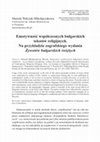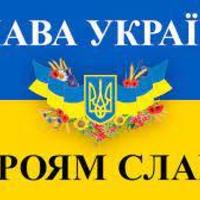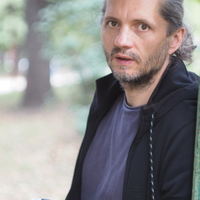Papers by Mariola Walczak-Mikołajczakowa
Przegląd Humanistyczny, Apr 23, 2023
Poznańskie Studia Slawistyczne, Sep 21, 2018
Bohemistyka
Autorka dokonuje przeglądu wydanych dotychczas 28 numerów czasopisma naukowego „Славянски диалози... more Autorka dokonuje przeglądu wydanych dotychczas 28 numerów czasopisma naukowego „Славянски диалози”. Pismo ukazuje się od roku 2004, a jego wydawca jest Wydział Filologiczny Uniwersytetu im. Paisija Chilendarskiego w Płowdiwie. Uwaga zostaje zwrócona na bohemistyczny wątek, obecny niemal we wszystkich wydanych tomach w ramach większości stałych rubryk, tworzących szkielet konstrukcyjny czasopisma. Autorka omawia też fenomen ogromnego zainteresowania kulturą czeską w Bułgarii, wyjaśniając jego przyczyny. Szczegółowo zaprezentowane są 3 tomy poświęcone zagadnieniom z zakresu kultury i literatury czeskiej.

Philological Review
For several weeks now, two colors have dominated the landscape of Polish cities – blue and yellow... more For several weeks now, two colors have dominated the landscape of Polish cities – blue and yellow. In this way, by hanging Ukrainian flags, we show solidarity with the neighboring nation affected by the defeat of the war. The authors of the article analyze the ways of perceiving, and thus naming or describing, these colors by Polish language users. They focus on traditional, commonly used names, as well as methods of describing the shades of both colors. To this end, they use the international RAL system, introduced in 1927 and used by dye manufacturers and traders from various industries. The internationalization of this system made it necessary to work out an appropriate name for each color in each language. The article also includes a short description of the symbolic meanings of both colors. Keywords: colors, nomenclature, descriptive names, semantics, RAL system.
Poznańskie Studia Slawistyczne, 2021
Artykuł zwiera recenzję książki Marineli Mladenovej Банатски български книжовен език в контекста ... more Artykuł zwiera recenzję książki Marineli Mladenovej Банатски български книжовен език в контекста на славянската микролингвистика. История, динамика на нормата и езикови политики, której autorka skupia się na normalizacji i rozwoju norm języka bułgarskiej mniejszości zamieszkującej Banat. Literacki język Bułgarów z Banatu ma status języka wyspowego, gdyż posługuje się nim katolicka społeczność od ponad dwustu lat żyjąca poza ojczyzną, w obcym otoczeniu językowym. Z czasem – w dużej mierze pod wpływem języka chorwackiego, rumuńskiego i węgierskiego – rozwinął własną normę literacką i uznawany jest dziś za mikrojęzyk. Książka Marineli Mladenowej, a w ślad za nią także niniejszy artykuł dotyczą czynników politycznych i społecznych, które oddziaływały na rozwój tej normy.
Balcanica Posnaniensia. Acta et studia
Tak zwana Braszowska gramota jest dokumentem, który pod koniec XIV wieku wyszedł z kancelarii ost... more Tak zwana Braszowska gramota jest dokumentem, który pod koniec XIV wieku wyszedł z kancelarii ostatniego bułgarskiego władcy, Iwana Sracimira. Ten niewielki, liczący zaledwie 7 wersów tekst jest przykładem średniowiecznej umowy międzynarodowej opartej na wzorcach bizantyjskich. Car nadaje zwalnia w nim od podatku kupców z Braszowa, nadaje im swobody handlowe i gwarantuje swoją opiekę. Mimo skromnych rozmiarów, gramota Iwana Sracimira od lat stanowi obiekt burzliwych dyskusji naukowców różnych dziedzin. Artykuł zawiera przegląd dotychczasowych ustaleń na temat daty jego powstania, znaczenia zawartych w nim treści, zastosowanej grafii, a przede wszystkim języka. Po raz pierwszy także treść Braszowskiej gramoty została przetłumaczona na język polski.
Poznańskie Studia Polonistyczne. Seria Językoznawcza, 2021
The article’s subject of interest is the language of the Travel Diary written by the Cossack hetm... more The article’s subject of interest is the language of the Travel Diary written by the Cossack hetman Pylyp Orlyk from 1720 to 1732 during a trip from Stockholm to Istanbul. The article refers to the so-called “macaronisation”, i.e. the saturation of the text with Latin and/or Italian words and borrowings from other languages, typical of Polish texts of the Baroque period. A large part is devoted to Turkish words because a significant part of Pylyp Orlyk’s journey went through the lands belonging to the Ottoman Empire in the eighteenth century.
Poznańskie Studia Slawistyczne
Bulgarian works of a non-religious nature began to be written in the 19th century. They populariz... more Bulgarian works of a non-religious nature began to be written in the 19th century. They popularized a specific vision of a new literary language and contained suggestions of terms from various fields. Sophronius, bishop of Vratsa belonged to the group of writers who significantly influenced the shape of New Bulgarian literary language. By translating Aesop’s fables into a language understandable to Bulgarians, he laid the foundations of Bulgarian animalistic terminology. The author analyses 66 names of animals contained in the fables translated by Sophronius, indicates their origin and the reasons for using a specific term. She further examines which of these terms are still used, and which have become archaisms or have survived only in folk dialects.
Zeszyty Cyrylo-Metodiańskie
Autorka omawia wydaną w 2020 roku książkę Magaleny Abadżiewej Ръкописният българо-италиански речн... more Autorka omawia wydaną w 2020 roku książkę Magaleny Abadżiewej Ръкописният българо-италиански речник на отец Маурицио от 1845 г. Изследване и текст, nawiązując do niektórych wątków z historii bułgarskich katolików i dziejów ich piśmiennictwa. Badaczka potwierdza tezę, że dzieło autora-cudzoziemca jest znaczącym wkładem do dorobku bułgarskiego piśmiennictwa katolickiego i stanowi cenne źródło wiedzy o dialekcie paulicjańskim.
Symbolae Philologorum Posnaniensium Graecae et Latinae
The article considers the Bulgarian translations of Aesop’s fairy tales done in the nineteenth ce... more The article considers the Bulgarian translations of Aesop’s fairy tales done in the nineteenth century. Then they occupied an important place in the textbooks for the newly emerging secular schools. As a popular reading, they also played an important role in the discussion on normalization of the Bulgarian language.
Zeszyty Cyrylo-Metodiańskie, Jan 10, 2018
Uniwersytet im. Adama Mickiewicza w Poznaniu WHAT WAS WRITTEN ABOUT WRITING? (ON THE MATERIAL OF ... more Uniwersytet im. Adama Mickiewicza w Poznaniu WHAT WAS WRITTEN ABOUT WRITING? (ON THE MATERIAL OF MEDIEVAL GLOSSES AND MARGINAL NOTATIONS IN OLD BULGARIAN LITERATURE). The article discusses the content of marginal notations extracted from Bulgarian manuscripts from 10 th-16 th century containing comments on the process of writing. The author focuses on notations that not only refer to the conditions, under which medieval codes are produced, but above all refer to the physical act of creating the text itself. The glosses discussed in the article describe specific writing materials-parchment, paper, ink and feathers. Information extracted from these marginal notations is confronted with the current knowledge on medieval writing methods.

Poznańskie Studia Slawistyczne, Dec 4, 2015
Usage of the word 'contemporary' in the title of this article persuades to think of issues which ... more Usage of the word 'contemporary' in the title of this article persuades to think of issues which were undertaken by editors of this volume: is emotiveness belong only to texts published by contemporary media, or do we have to accept her limitation to media discourse, or would it be considered in wilder terms and draw attention to variety of ongoing discourses. From this point of view it undoubtedly attracts attention to religious language (characteristic for particular countries and contemporary used), which is still undefined and fragmentarily described. From this perspective author analyses the hagiography language which is included in the most recent edition of Bulgarian monastery on the Saint Athos Mount. The author wonders how influential the exigence of contemporary recipient can be or how the writing tradition. Cited numerous examples try to prove that the religious language of Bulgaria is traditional and refers to inheritance of Old Church Slavonic.











Uploads
Papers by Mariola Walczak-Mikołajczakowa